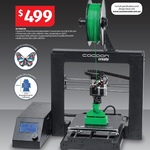A good size 3d printer is on sale in Aldi from the 17th as seen in the new catalog. The printer has more details at this website http://www.cocooncreate.com.au/ Lots of other 3d printing related items as well on sale:
3d printing pen 1.75mm ABS/PLA $79.99
PLA 3d Filament 1kg spool in green, grey blue and black $34.99




Looks very similar to the Wanhao i3 Duplicator.
http://www.wanhao3dprinter.com/Find/ShowArticle.asp?ArticleI…